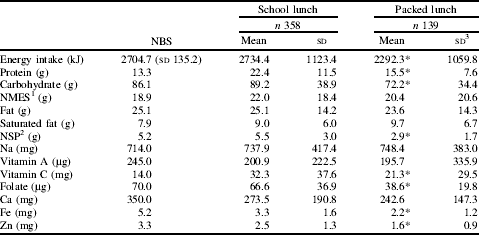In order to improve the quality of food provided in secondary schools, food-based standards (FBS) and nutrient-based standards (NBS) were introduced in 2007 and 2009, respectively(1). The standards do not apply to packed lunches but schools are encouraged to have a packed lunch policy(2). Research in primary schools comparing the nutrient intakes of pupils who consume either a school lunch or a packed lunch has shown that, on average, pupils who consume a school lunch typically have a more favourable intake of key nutrients(Reference Evans, Greenwood and Thomas3), to date no similar comparison has been carried out in secondary schools.
In 2008, the School Food Trust studied the effect in secondary schools of improving school food and the meal experience on pupil's postprandial behaviour in the classroom(Reference Storey, Pearce and Ashfield-Watt4). Ethical approval was obtained from Kings College London Research Ethics Committee. Lunchtime food and drink choices of pupils consuming either a school lunch or a packed lunch were recorded at eleven secondary schools. Portion sizes were either weighed or estimated by weighing duplicate portions of foods provided at the schools. Leftovers were weighed to calculate the amount of each food eaten by each child. Baseline data from this study were used to compare mean energy and nutrient intakes from school lunches and packed lunches.
Table 1. Mean and standard deviation of nutrients consumed, by type of lunch

1Non-milk extrinsic sugars 2 Non-starch polysaccharides 3 Standard deviation. *Mean values were significantly different from school lunches (ANCOVA adjusted for age, sex and school): P<0.05.
Pupils who chose a school lunch had significantly higher intakes of energy, protein, carbohydrate, NSP, vitamin C, folate, Fe and Zn than those who brought a packed lunch from home.
It is hoped that following the introduction of NBS in September 2009(1), the nutrient profile of secondary school meals will have improved; however, educating parents and pupils to make healthier choices for packed lunches is warranted.



